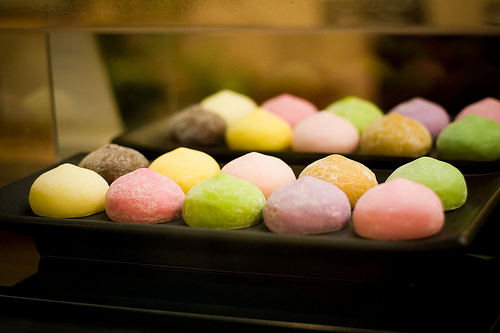Mochi is a Japanese rice cake made of glutinous rice pounded into paste and molded into shape. In Japan it is traditionally made in a ceremony called mochitsuki. While also eaten year-round, mochi is a traditional food for the Japanese New Year and is commonly sold and eaten during that time. Mochi is also a prominent snack in Hawaii, Taiwan and Thailand.Mochi is made by soaking short grain glutinous or sticky rice overnight, cooking it, and pounding it into a sticky paste. The paste is molded into shapes which range from simple round buns to complex ornamental pastries, some of which are stuffed with sweet fillings like lotus root and sweet red bean paste. Mochi is often decorated with fruit or flowers, especially when it is exchanged as a gift at celebrations like birthdays and the New Year. Fresh mochi is usually cooked and served warm with a variety of sauces. Steaming and boiling or simmering are both popular preparations in Japan, along with grilling. Baked mochi can be an unusual treat: it tends to puff up in the oven, creating an interestingly textured food which readily absorbs dipping sauces. Fresh mochi often molds readily, so it should be cooked or frozen within a few days of purchase. Mochi appears in a variety of dishes, not just in a plain presentation. Ice cream enclosed in mochi is a popular Japanese dessert treat, and mochi is often also used in soups. Depending on the soup, the mochi may be specially flavored and toasted, or left in plain dumpling form to cook with the soup and provide texture. In addition to being stuffed with sweet fillings, mochi can also be filled with boiled or pickled vegetables. Mochi can be very sticky, sometimes with perilous results for the diner, so beware! Inexperienced mochi eaters may want to stick with small bites of the confection to avoid the potential choking hazard.


 字體:小 中 大
字體:小 中 大









